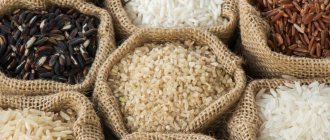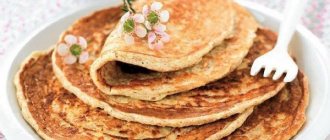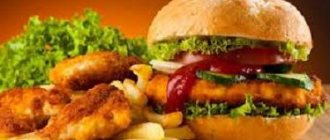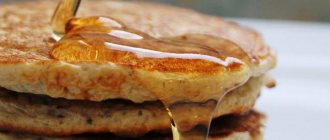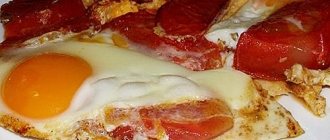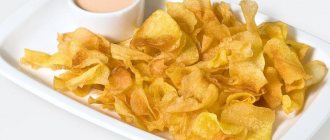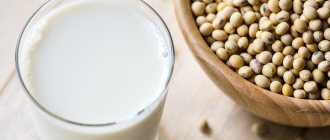Tips for choosing ingredients and cooking tricks
The main difference between a dietary casserole and a traditional one is its low calorie content. Depending on the components, it varies from 60 to 100 kcal per 100 grams, and the kilocalorie content in a regular one is from 150 to 200 kcal. This fact is due to the products that are used for cooking.
It is not acceptable to use for cooking:
- flour (semolina or oatmeal is added instead);
- sugar (natural sweeteners or sweet fruits are recommended);
- classic cottage cheese (analog - low-fat or low-fat).
Cottage cheese is a very healthy product that must be present in the diet. It contains easily digestible protein, vitamins and lactic acid bacteria that improve the functioning of the digestive system. But most importantly, cottage cheese is rich in calcium, which is necessary for the normal functioning of the body. To prepare the casserole, you should not use a low-fat product: it is better to give preference to three or five percent cottage cheese. Low fat content interferes with calcium absorption, making the dish less healthy.
As a sweetener for dessert, you should give preference to natural sugar substitutes: stevia, maple syrup, erythritol, etc.
To prepare a tasty and healthy casserole that will literally melt in your mouth, consider these recommendations:
- To give the dish a more delicate and uniform consistency, the cottage cheese should be rubbed through a fine sieve or mixed in a blender.
- It is recommended to beat the egg white as long as possible;
- Excessively dry cottage cheese must be diluted with low-fat kefir or natural yogurt.
- adding vegetables, fruits and berries will make the delicacy tastier, more aromatic, and most importantly, healthier.
- for baking it is best to use a silicone mold;
- The finished curd dessert should not be taken out of the oven immediately; you need to let it cool a little.
- jam, jam, jelly, cream and other additives with which you can serve the casserole will make its taste even brighter and richer. The main thing is that they are dietary.
Pros and cons of the cottage cheese diet
Cottage cheese is a source of methionine, an amino acid with an antioxidant effect. The following properties of fermented milk products are important for weight loss and health improvement:
- acceleration of metabolism;
- proper distribution of fats;
- small amount of carbohydrates (1.8–3%);
- improved digestion;
- prevention of atherosclerosis;
- strengthening the skeletal system, hair, nails and teeth;
- improvement of intestinal function;
- low calorie content (71 kcal/100 g low-fat product);
- skin improvement;
- normalization of the nervous system.
You should not abuse the cottage cheese mono-diet. Undesirable consequences:
- oversaturation of the body with protein, which will lead to disruption of the liver;
- swelling due to potassium, which retains salt in the body;
- lack of vitamins, microelements, fiber;
- the risk of intestinal infection when consuming a stale product.
The cottage cheese diet for weight loss has several contraindications. This:
- lactose intolerance;
- food allergies;
- cardiovascular pathologies;
- kidney diseases;
- increased calcium levels in the blood (hypercalcemia);
- pregnancy, lactation period (long-term mono-diet);
- chronic diseases of the stomach or intestines.
Classic cottage cheese casserole in the oven
Fans of traditional casserole who are on a diet can enjoy a dietary version of the dessert. You can bake it in the oven, slow cooker and microwave.
Classic PP cottage cheese casserole is prepared from the following ingredients:
- 500 grams of cottage cheese (1% or 5%);
- 2 tablespoons of semolina;
- 2 eggs;
- sweetener to taste;
- 1 tablespoon sunflower oil;
- 1 packet of vanilla.
Preparation:
Place the cottage cheese in a container and grind thoroughly. Add eggs, semolina, vanillin and sweetener. Mix all ingredients well with a fork or mixer. Place the resulting mass in a mold greased with sunflower oil and place in an oven preheated to 180 degrees. Bake for about half an hour until golden brown.
You can serve dessert with dietary jam, jam or marmalade.
Cottage cheese casserole in a slow cooker
It is very convenient to use a slow cooker to prepare casseroles. This method produces a delicious curd delicacy that the whole family will enjoy.
Required ingredients:
- 600 grams of cottage cheese (from 1% to 5%);
- 1 egg;
- 5 tablespoons of semolina;
- 4 tablespoons of 15% sour cream;
- sweetener to taste;
- berries, fruits optional.
Preparation:
Place the cottage cheese in a deep bowl and mash it well with a fork. Then add egg, semolina, sour cream and any sweetener to taste. For example, you can use a natural sugar substitute - fructose. If desired, you can add your favorite fruits or berries. It is important to take into account that some of them produce juice, so the dough may turn out to be too liquid. Mix the mixed ingredients thoroughly with a mixer and place in a multicooker bowl greased with vegetable oil. Turn on the “baking” mode and wait for it to be ready. Any dietary jam or marmalade that can be added to the finished dessert will make the dish even tastier.
Sweet curd pastries
To diversify the taste of your usual casserole, add sweet ingredients to the finished dough instead of sugar.
- Dried fruits.
For example, raisins, dried apricots, prunes, figs, any dry berries, pitted cherries. Dried fruits can be mixed evenly with the dough, or they can be laid out in a separate layer between the curd layers. - Fruits and berries
. For example, apples, plums, peaches, apricots, cherries, oranges and other fresh, frozen or canned fruits (berries). It is better to cut the fruits into thin slices or small cubes. The finished product will be elegant. If you prepare puree, the baked goods will have a uniform texture. - Confiture
, marmalade, jam, preserves. These sweet ingredients make curd baked goods attractive to children, but are completely unsuitable for dietary nutrition.
I myself love blackcurrant casserole. Sour taste, wonderful color and aroma. My mom likes it better with apples.
With apple
Low-calorie cottage cheese casserole with apples turns out very tasty and aromatic.
To prepare it you need:
- 400 grams of cottage cheese (from 1% to 5%);
- 3 eggs;
- 4-5 medium sized apples;
- 5-6 tablespoons of semolina;
- 150 ml milk;
- sweetener to taste;
- 1 packet of vanillin;
- 1 pinch of salt.
Mix the egg yolks with sweetener and beat thoroughly with a mixer. Then add milk, semolina, vanillin and beat again. Leave the resulting creamy mixture for 20 minutes so that the semolina swells. Cut the apples into small pieces. You shouldn’t peel them: it contains a lot of vitamins. Beat the egg whites with a pinch of salt and add to the curd mixture. Transfer half of the mixed mass into a greased pan, and spread the apple slices on it in an even layer. Spread the remaining dough on top. Place the pan in an oven preheated to 200 degrees and bake for 45-50 minutes.
When serving, you can add diet cream.
From cottage cheese without semolina
Those for whom losing weight is a fixed idea will love this dietary casserole without adding semolina. This dish is not inferior in taste to others, but turns out to be even lower in calories.
Required ingredients:
- 500 grams of cottage cheese (from 1% to 5%);
- 2 tablespoons of low-fat kefir;
- 2 eggs;
- sweetener to taste;
- a handful of raisins.
Mix the cottage cheese and kefir thoroughly with a fork. Beat the eggs with a mixer, gradually adding sweetener. Mix the curd mass with beaten eggs and add pre-soaked raisins. Place the resulting mixture in a greased pan and place in an oven preheated to 200 degrees. Bake until done.
Is it possible to eat cheesecakes "drying"?
Many generally do not accept the term “cutting” in relation to the diets of amateurs who are preparing, rather, for going to the beach in a bikini, rather than for competitions. Be that as it may, we will understand by “drying” a decrease in the percentage of fat from normal (about 20-25) to low. This is where you have to say goodbye to classic recipes with sugar and flour. Here's why: Sugar and flour can cause a strong insulin spike and significant fluctuations in blood glucose levels. Cheesecakes will not reduce your appetite, but rather increase it if you have been following a low-carb diet for a really long time; Some people have problems digesting cottage cheese. They have an allergic reaction to the digestion products of casein, and they are “flooded” with water. For an amateur bodybuilder, this is a compelling argument to give up cottage cheese for the entire period of preparation for competitions or important events; not everyone can fry cheesecakes efficiently in a minimum of oil, and “done” fats are not at all what we would like to see on our plates if we generally reduce the amount of fat we consume
So we should pay attention to baked versions of the dish, or completely abandon it in favor of just cottage cheese with just a sweetener
In general, dietary recipes for cheesecakes are acceptable for “drying”. You can take them from the "works" of the Dukan diet, or change your favorite regular recipe so that it suits your weight loss goals.
How to cook low-calorie cheesecakes The
following will help us reduce the number of calories in the dish:
mixing a spoonful of flour with a spoonful of oat or wheat bran. They are rich in fiber and can reduce the “calorie load” on the body by half; replacing simple sugar with a sweetener, for example, based on stevia or erythritol, or any other that does not contain calories and can dissolve well in baked goods; replacing 9% cottage cheese with 0%, the low-fat product will need to be whipped with a spoon of milk so that it acquires the texture of cream; You can add two whites instead of an egg, or buy liquid whites in a bottle and add 1-2 tablespoons of them to the finished product.
The classic “light” recipe requires us to take 200 g of low-fat cottage cheese, beat it with 2-3 egg whites and a couple of spoons of milk until it reaches the consistency of a paste, and then add corn starch and bran, about a spoonful at a time. Next, add vanilla extract with stevia to taste, and mix everything well. Place the cheesecakes in a frying pan coated with cooking spray and fry.
Advice: it will be better if you choose a high-quality frying pan with a ceramic coating, so as not to waste energy on “unsticking” cheesecakes that stick to the bottom. If butter doesn’t fit into your diet at all, you should consider the option of cottage cheese casserole on a baking sheet lined with parchment.
In general, cheesecakes are suitable for almost everyone, except those who are lactose or casein intolerant. They are tasty, healthy, familiar to us since childhood and can be a component of a healthy diet.
In the microwave
A delicious casserole with a minimum of calories can be prepared in a hurry. In this case, an irreplaceable assistant in the kitchen comes to the rescue - the microwave.
So, you will need the following ingredients:
- 500 grams of 5% cottage cheese;
- 2 eggs;
- 100 ml milk (3.2%);
- 30 grams of cocoa powder;
- 100 grams of oatmeal;
- sweetener to taste;
- 1 packet of vanillin;
- 1 pinch of salt.
Preparation:
Add sweetener and salt to the beaten eggs to taste. Then mix everything with cottage cheese and pre-ground oatmeal in a blender. Divide the resulting mass into 2 parts, add cocoa to one of them. Place the mixture in a greased pan, alternating light and brown layers. Bake in the microwave for 12 minutes at 600 W power.
Before eating, the chocolate treat can be lightly greased with diet jam or marmalade.
With pumpkin
Pumpkin can be one of the components of a dietary cottage cheese casserole. An unusually healthy vegetable will give the dish an original taste and saturate the body with vitamins.
Ingredients:
- 500 grams of five percent cottage cheese;
- 3 eggs;
- 200 grams of pumpkin;
- 100 grams of sour cream with 15% fat content;
- 70 grams of chopped oatmeal;
- 1 teaspoon baking powder;
- sweetener to taste.
Preparation:
Mix cottage cheese, egg yolks, cereal, baking powder and sweetener (to taste). Beat the whites thoroughly with a mixer, add the curd mass and pre-grated pumpkin on a fine grater. The juice that the vegetable will release must be squeezed out. In order not to lose the splendor, you need to mix these components as carefully as possible. Place the pan in the oven, preheated to 180 degrees and bake for 45-50 minutes.
Unsweetened curd pastries
Feeding a child cottage cheese or carrots is not at all easy. This is probably why carrot casserole with cottage cheese is still the most unpopular. Although from a dietary point of view, it is the most useful.
Curd and carrot casserole can be either sweet or savory. A savory casserole with the addition of fresh vegetables and herbs can be an excellent second course.
Vegetables for unsweetened cottage cheese baking can be used finely chopped raw or pre-stewed.
In addition to carrots, pumpkin, zucchini, zucchini, tomato, cauliflower and broccoli go well with cottage cheese.
The mixture is prepared from cottage cheese, eggs and flour (semolina) without sugar. Add salt. but we won't. You can also chop greens: dill, parsley.
The vegetables in the casserole preparation can be mixed and then placed in the pan. You can do it differently: put the curd mass and a layer of vegetables into the mold in layers.
There is another curd mass on top. To obtain an appetizing crust, sometimes the top of the dish is sprinkled with grated cheese. This will definitely add calories, but it looks delicious.
With banana
You can prepare an excellent casserole even without using sweeteners. They will be replaced by a banana, which will give the dessert an amazing taste.
Required ingredients:
- 300 grams of cottage cheese (from 1% to 5%);
- 2 eggs;
- 2 ripe bananas;
- 50 ml low-fat milk;
- 2 tablespoons of semolina;
- 1 packet of vanilla.
Preparation:
Pour milk over the semolina and leave for 20-25 minutes. Mix cottage cheese and eggs with pre-mashed bananas with a fork. Add swollen semolina with vanilla to the resulting mixture and mix thoroughly. Place the curd mass in a mold and place in an oven preheated to 200 degrees for 45 minutes.
Cottage cheese-banana dessert can be flavored with low-fat sour cream before eating.
With carrots
An amazing dietary treat is made from cottage cheese and carrots. Orange source of vitamins is not only very healthy, but also tasty.
To try the cottage cheese and carrot casserole, you need:
- 300 grams of cottage cheese (from 1% to 5%):
- 1 tablespoon of kefir;
- 2 eggs;
- 1 large carrot;
- 1 packet of vanillin;
- sweetener to taste;
- 1 teaspoon baking powder;
- 1 pinch of salt.
Preparation:
Pass the cottage cheese through a sieve. If it is dry, you need to dilute it with a small amount of kefir. Mix eggs with sugar substitute, salt and beat thoroughly with a mixer. Add pre-boiled carrots grated on a coarse grater, cottage cheese, baking powder, vanillin and mix thoroughly. Place the resulting mass in a silicone mold and place in the oven. Baking time – 35-40 minutes at 200 degrees.
You can serve carrot dessert with diet jelly, jam or low-fat sour cream.
Types of cottage cheese diets
Curd diet for 3 days
There are several types of diets using cottage cheese, the most optimal of which is a 3-day diet.
Dishes containing cottage cheese are basic, but they can be diluted by including fruits, vegetables, cereals, juices and unsweetened tea in the menu.
The three-day diet recommends eating the main curd dish during lunch. During breaks after main meals, you can eat an orange, cucumber, drink a glass of juice, mineral water or a cup of green tea. This helps to diversify the menu somewhat and make it more satisfying. Over the entire period of such nutrition, you can lose up to 5 extra pounds.
This type of diet is more strict compared to its other options. With this diet, you need to eat 200 g of cottage cheese every 2-3 hours without any additives (for example, sour cream, sugar and salt). To dilute the cottage cheese a little, you can add citrus fruits, natural low-fat yogurt, a little dried apricots or honey. It is recommended to wash all this down with 1% kefir, which improves the absorption of this dish. During such a diet, according to nutritionists, you can lose not only up to 4 kg, but also reduce the volume of your stomach and improve your health.
Cottage cheese diet for a week
A week of diet helps you lose 3-4 kg of excess weight.
For breakfast, it is recommended to eat unsalted oatmeal (small portion), boiled lean meat (100 g) and vegetables (cucumber, tomato). Morning tea can be supplemented with 1 teaspoon of honey or jam.
For lunch you are supposed to eat a portion of cottage cheese or a dietary dish made from it (200 g). The meal can be complemented with rye toast.
Dinner is similar to lunch, but you will have to give up bread.
You can use apples as snacks.
Throughout the day you need to drink 1.5-2 liters of free liquid (it is recommended to drink 1 glass of water shortly before meals).
It is quite acceptable to combine diet with sports
Kefir-curd diet
A kefir-curd diet designed for 7 days allows you to lose about 5-7 kg. Fermented milk products, including cottage cheese and kefir, activate metabolic processes in the body, resulting in increased fat burning.
Every day you can eat 300 grams of low-fat cottage cheese and drink 1.5 liters of low-fat (1%) kefir
It is important that kefir does not contain additives, sweeteners or colorings, otherwise there will be no desired effect from following the diet. The daily norm is divided into 6 servings, food intake is alternated: one intake is 500 ml of kefir, the second intake is 100 g of cottage cheese, and so on.
The daily norm is divided into 6 servings, the food intake is alternated: one intake - 500 ml of kefir, the second intake - 100 g of cottage cheese, and so on.
Despite the obvious benefits of the cottage cheese and kefir-curd diet, exit from them should be carried out gradually and carefully. First you need to add some fruit, then cereal dishes, and even later - lean meat
To prevent lost kilograms from quickly returning, it is not recommended to consume sweets for another two weeks.
Curd and vegetable diet
A two-week cottage cheese diet using fresh vegetables has proven itself very well.
The daily intake of cottage cheese in this case should not exceed 300 g, but it is allowed to eat up to 500 g of cabbage, carrots, zucchini, tomatoes and cucumbers. The principle of this diet is also based on separate nutrition.
In the morning and at lunch, you should eat low-fat cottage cheese without any additives, and cook vegetables for second breakfast and dinner. If they seem unappetizing in their raw form, then cabbage, zucchini and carrots can be baked in the oven or stewed without adding salt and spices, and prepare a salad from cucumbers and tomatoes, adding no more than 1 teaspoon of vegetable oil.
You can use absolutely any vegetables, including exotic avocados. The only exception is potatoes, which are absolutely incompatible with cottage cheese and can cause digestive problems. In this case, the amount of liquid consumed daily should be at least 2-3 liters, including tea and weak coffee without sugar.
Cottage cheese-apple diet
This diet option includes in the menu:
- minimum fat cottage cheese - 200 g;
- green apples - 1.5-2 kg;
- water and unsweetened teas - at least 1.5 liters.
The diet should be divided into 5-6 servings. In between meals, you should drink enough liquid.
The duration of this weight loss method should not exceed 5-7 days (ideally, you should devote only 1-2 days to such a diet, using the fasting menu).
